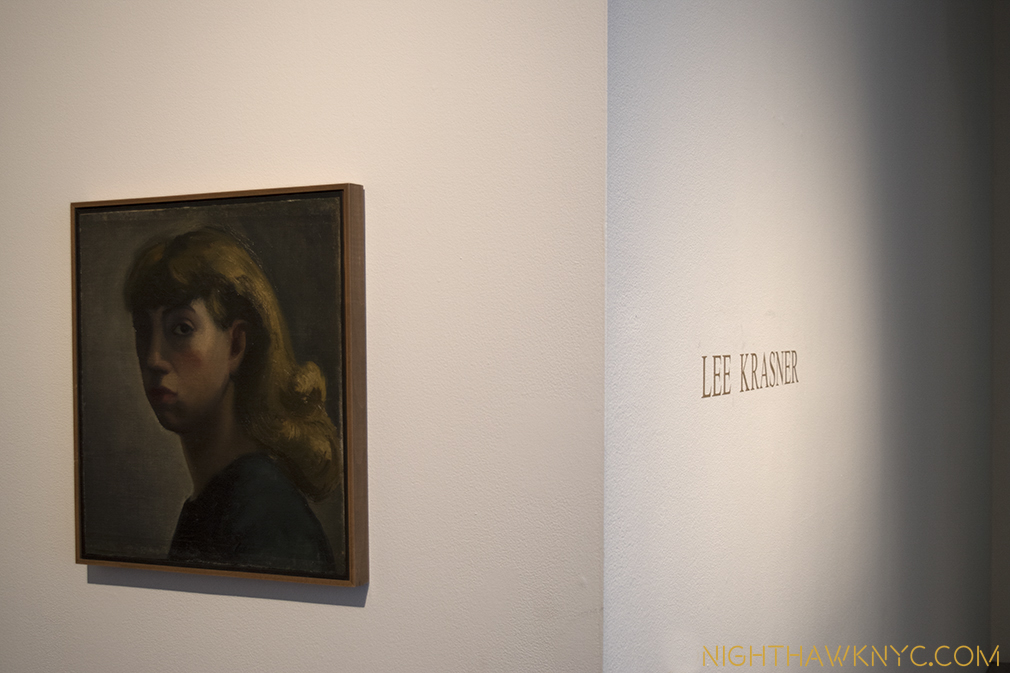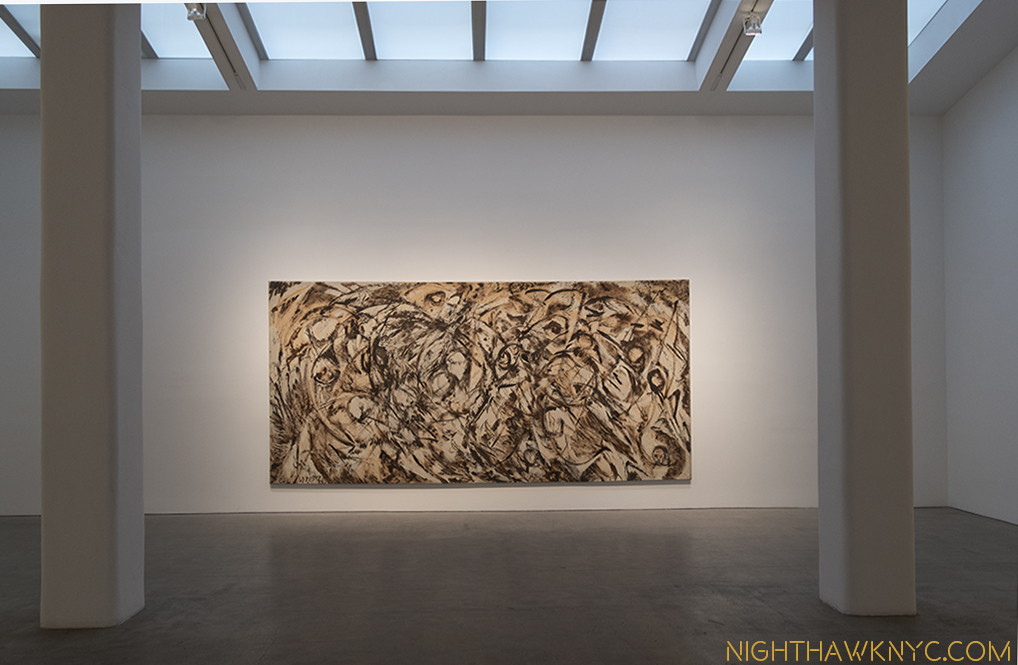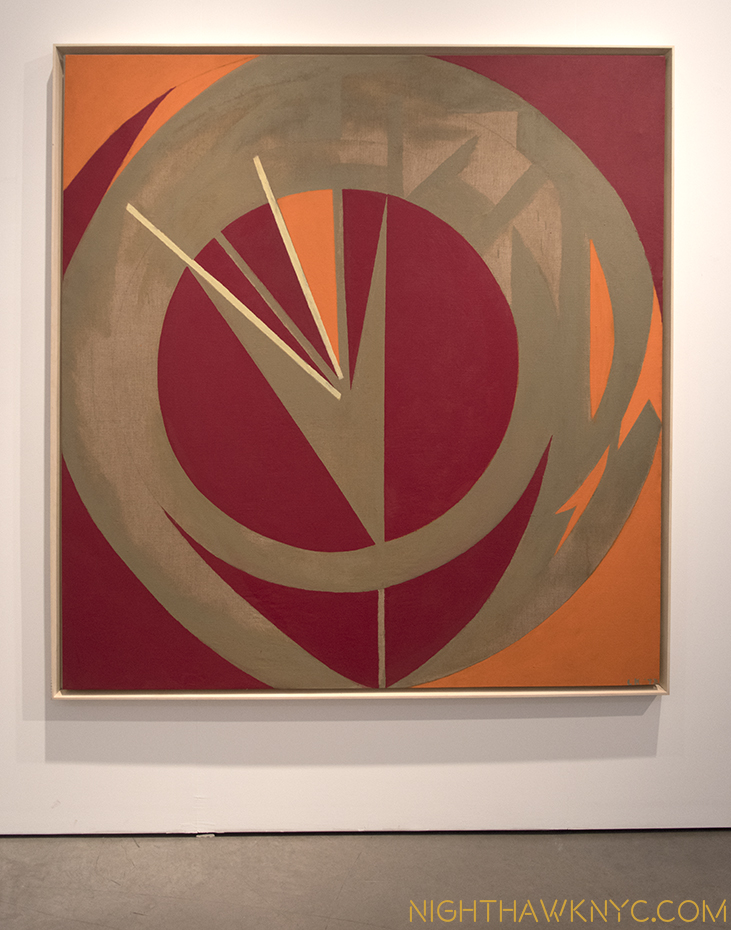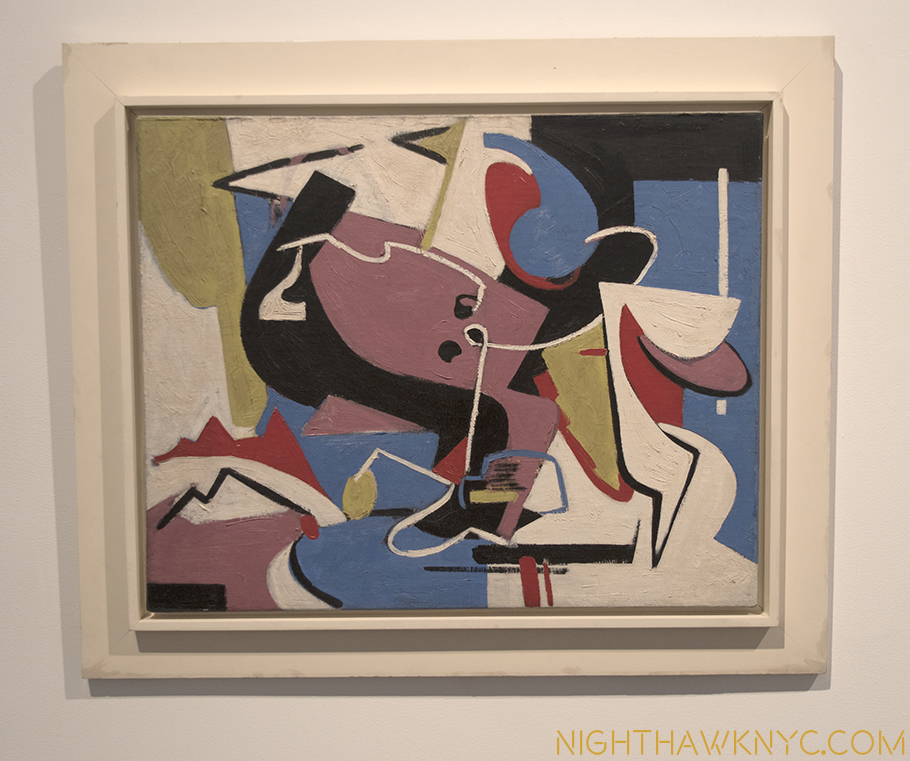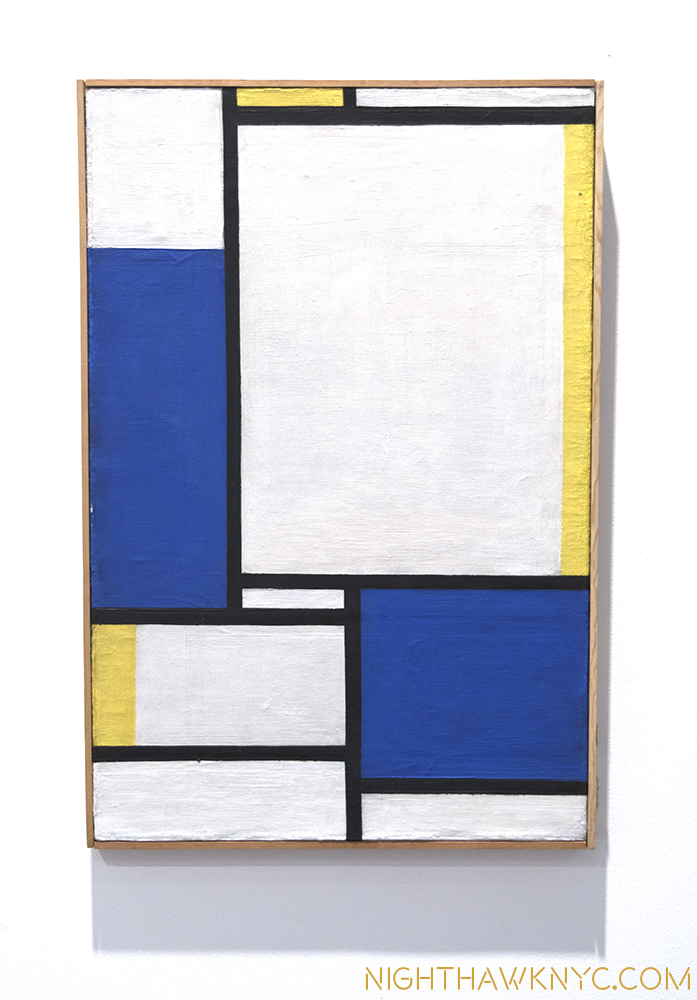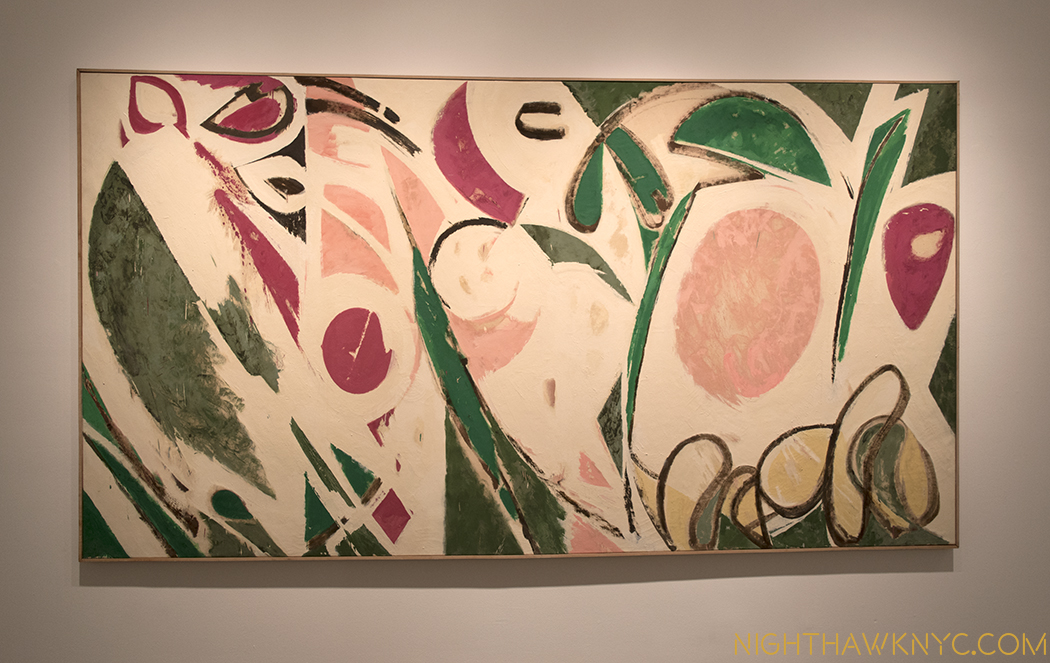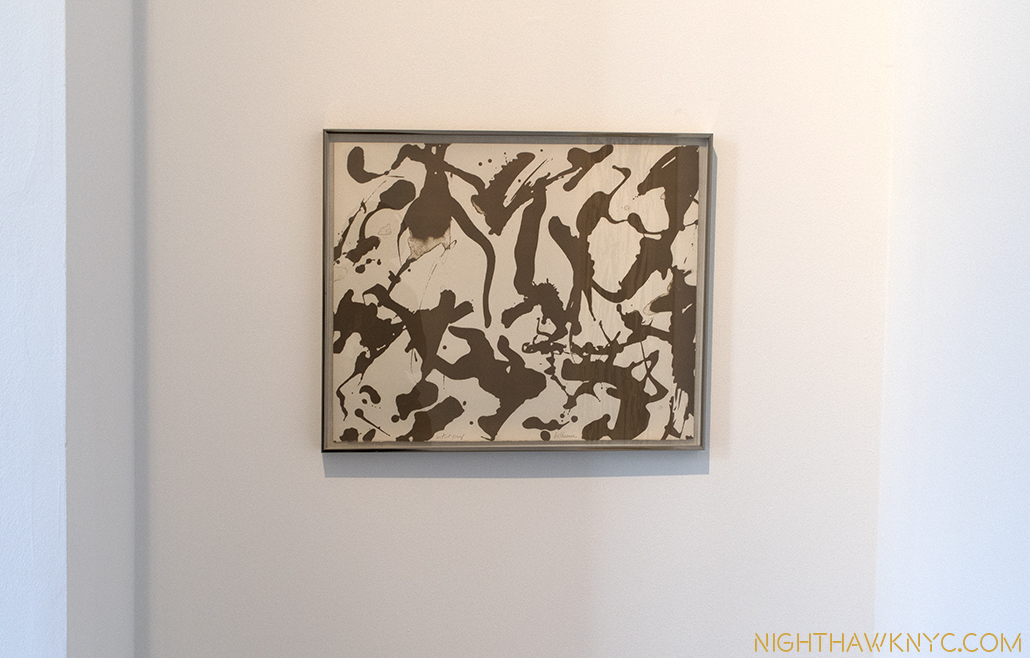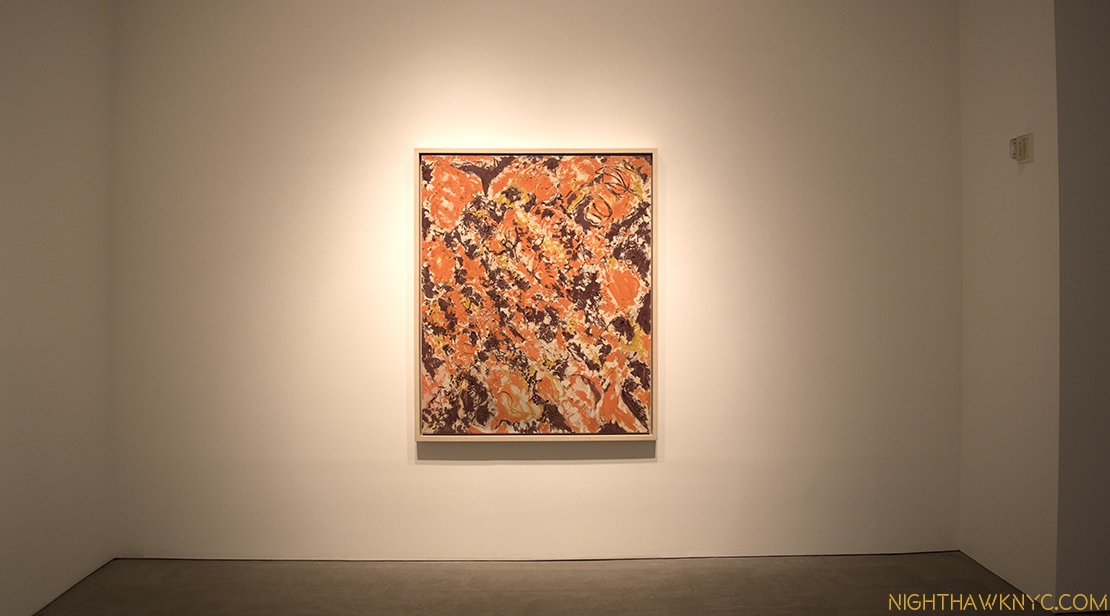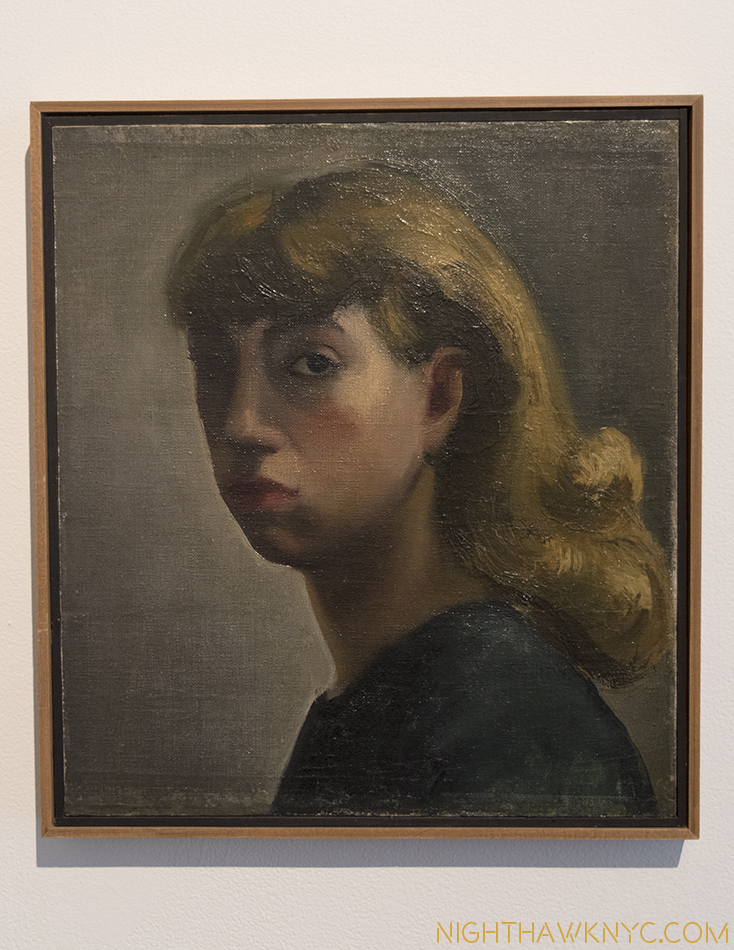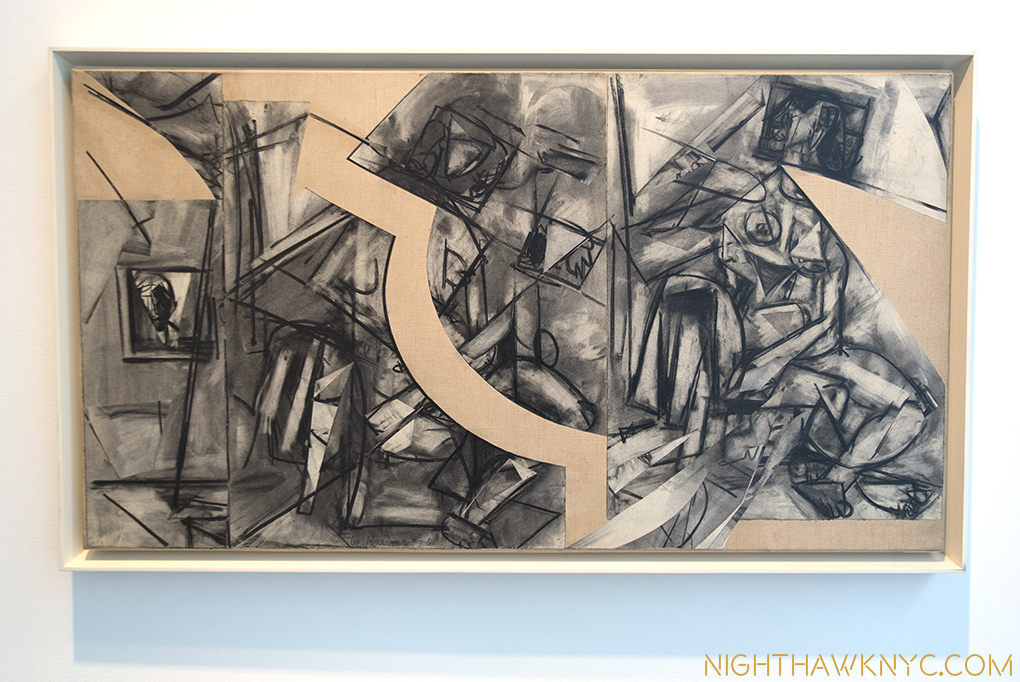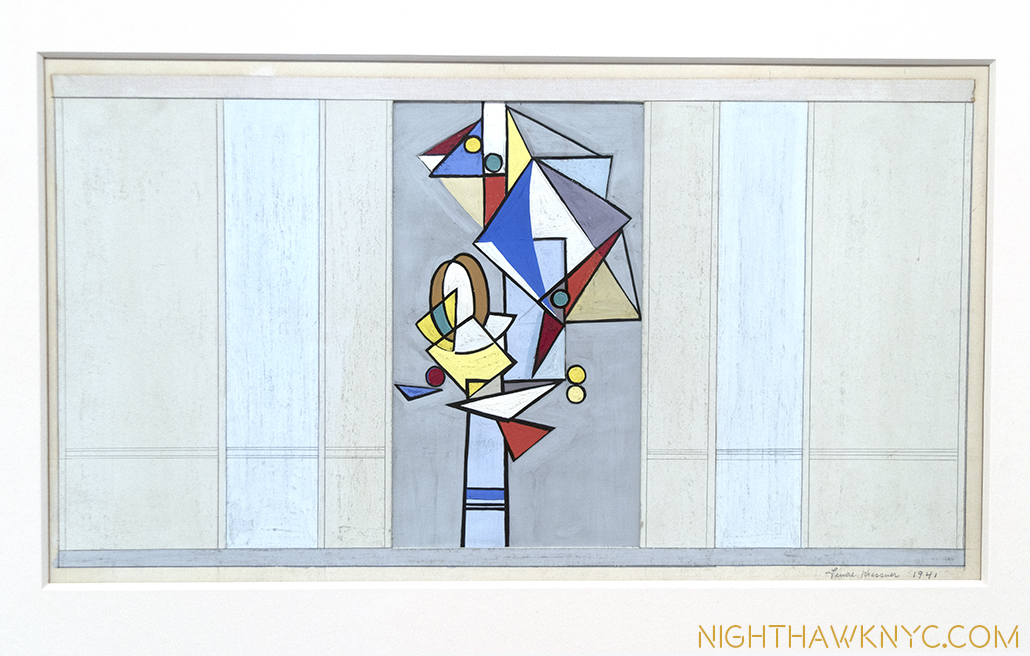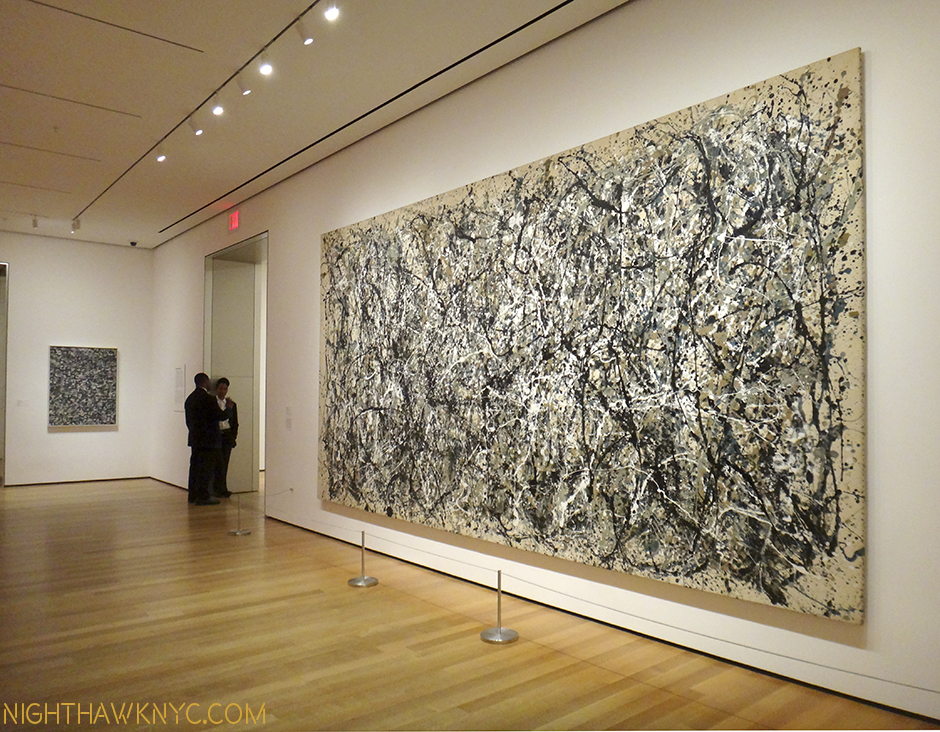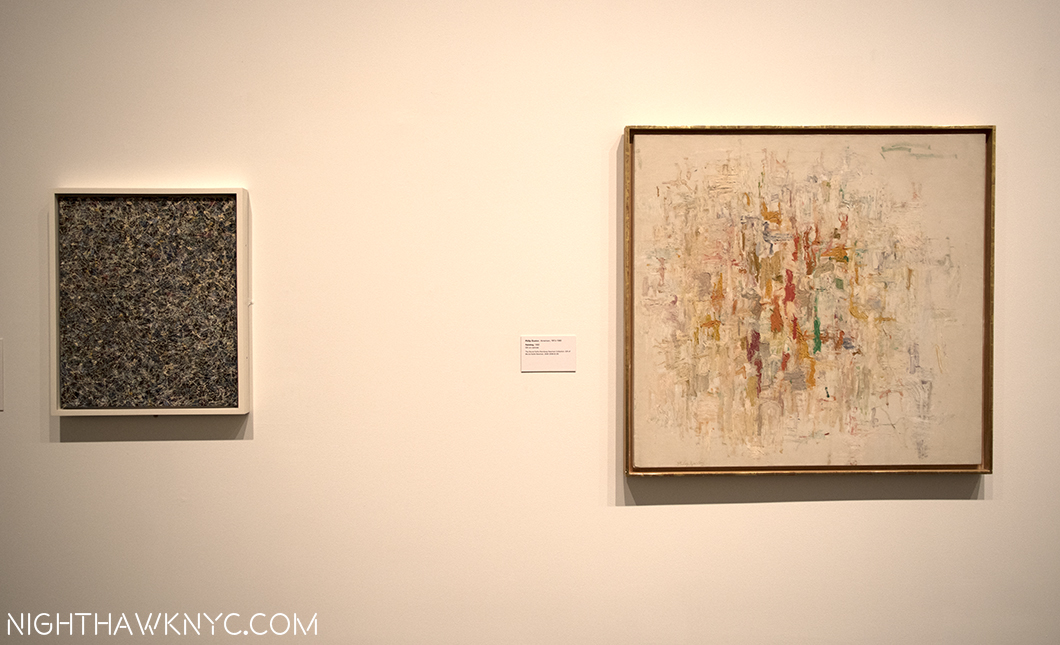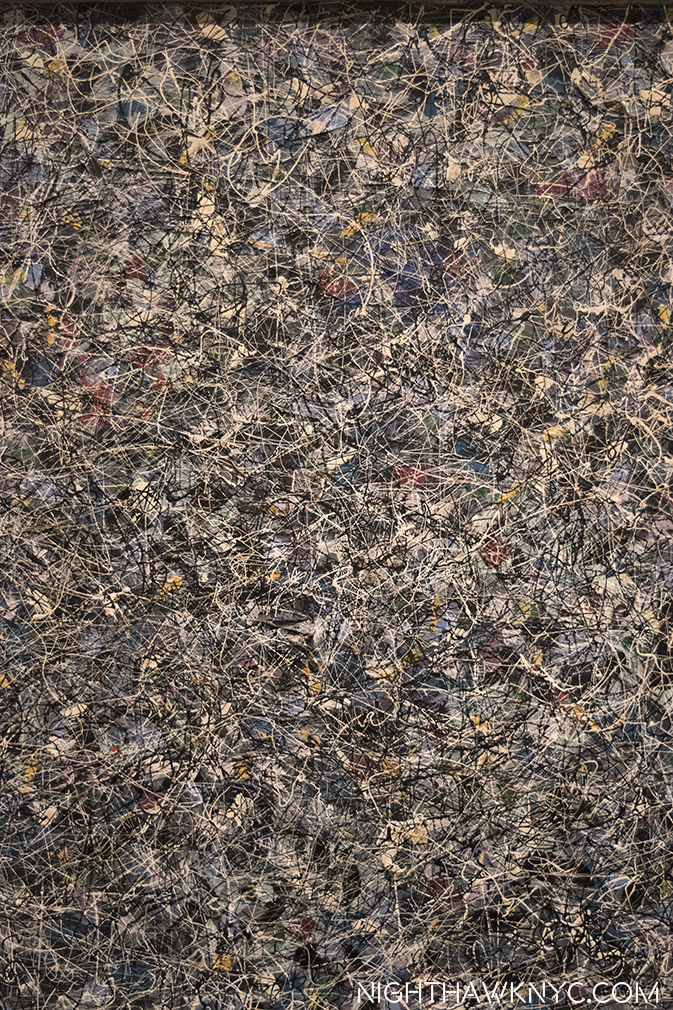This site is Free & Ad-Free! If you find this piece worthwhile, please donate via PayPal to support it & independent Art writing. You can also support it by buying Art & books! Details at the end. Thank you.
Written & Photographed by Kenn Sava (*- unless otherwise credited)
Recently, the Art Show Scheduling Gods smiled, and? Voila! A rare chance to see shows of three Artists with an intriguing connection (almost) side by side. I bowed to give them thanks for concurrent shows of Jackson Pollock (at MoMA), Lee Krasner (at Robert Miller Gallery) and Philip Guston (at Hauser & Wirth Gallery). The common thread being Pollock. One was married to him for 11 of the 14 years they knew each other. The other considered him his closest boyhood acquaintance. Pollock’s sudden death on August 11, 1956- 60 years ago this week as I write, left a personal and professional void in the lives of both. Then there was the “shadow” of Pollock’s legend they lived under the rest of their lives, which delayed full understanding and appreciation of their own accomplishment and importance. Delayed. Thankfully, not cancelled. Having already written about the Pollock show, this Post is about the Lee Krasner show, and a Post about the Philip Guston show follows.
First, consider Lee Krasner’s Short “Curriculum vitae,” i.e.- some of what she had to overcome-
- -Being an “Artist’s wife,” while married to Jackson Pollock from 1945-1956, a man she would remain devoted to from when they met in 1942, on.
-Pollock’s rise from barely known to sudden fame in August, 1949. A fame he never adjusted to placing immense burden on her.
-His death in a car crash (beside another woman, who later wrote a book about she and Pollock) while Krasner was away in Europe. She never remarried.
-Pollock’s legend, gowing larger in death, helped in no small part by her own efforts, and it’s impact on her own career
-Working as a Painter for 50 years- before, during and after him, in a somewhat similar realm
-Knowing personally, and working among, many of the greatest “first generation Abstract Expressionists,” from which she was unfairly excluded.
-Being a woman in a man’s field.
Sounds like a character in a movie. Lee Krasner had to overcome all of that, and yes…the movie. The movie being 2000’s “Pollock,” featuring Marsha Gay Harden’s Oscar winning portrayal of herself, which Krasner’s biographer, Gail Levin, summed up saying “Inaccuracy about Krasner’s life” was “endemic in the film.” 1 As I wrote about the recent Miles Davis film, and while I am al for artistic license and freedom in the Arts, not nearly enough respect gets paid to the lasting impact to historical persons in so-called “bio-dramas.” The effect of the damage these films do is real and long lasting. It makes me wonder what “good” they do. Most often, the subject is dead and can no longer do anything to defend themselves. Digging out from the wake of Jackson Pollock (who’s work she said first hit her “like an explosion”), the man, the legend, and the shadow, has been a long, arduous and thorny road. It’s a jumble that is still being traversed, and reversed, as we speak.
In spite of having been an Artist before she met Pollock in 1942, and for the better part of 30 years after his passing, it must be made clear that Lee Krasner was in no small way responsible for his shadow having grown so large 2. She did more than anyone to further Jackson Pollock’s career and his Art, during and after his life, and, as a result, and with the assistance of many others holding her back, her own Art has had as hard a road to acceptance as almost any other Artist in the 20th Century. Much more so than even Pollock’s, who was considered the “ultimate outsider.”
Ever so slowly, but surely, her Art has grown in stature over time. Unfortunately, she died just months before MoMA gave her a retrospective in 1984, making her (still) one of the few women to have gotten one. In 2011, Gail Levin released the first full-length biography of her mentioned above. The auction market has been increasingly responsive to her work, as well. First, the Cleveland Museum bought “Celebration,” from 1960, for 1.9 million, then in May, 2008, her “Polar Stampede” sold for 3.1 million3. Based on how much the work of the other first group of Abstract Expressionists sells for, I think her market still has a ways to go. Beyond transactions involving Museums, I care not about how much anyone else pays for Art- it’s meaningless, IMHO, since individuals buy Art for personal or investment purposes, to discussions about “Art.” In Lee Krasner’s case, I merely point it out to show another wall coming down.
In spite of all of this, I believe that Lee Krasner is, still, under appreciated- for her impact on the world of Art, as well as for her Art, which finally can be seen on it’s own, as it is here.
So, with all this in mind, my path still freshly worn, and my shoes, apparently, retaining their muscle memory of the way from the baker’s dozen visits I had just made to Robert Miller Gallery for “Patti Smith-18 Stations,” which had ended the week before, I returned to darken the doorway of this all too familiar space yet again. I will admit- it was a strange feeling to turn that corner half way down the gallery and not see Patti Smith’s chair & table (let alone, Ms. Smith, herself!) from Cafe ‘Ino and “M Train,” and not to see the handwritten pencil notations she’d written on the eastern wall (did they paint over them? Or are they possibly now hidden but protected behind a fake outer wall, like Leonardo Da Vinci’s long lost “Battle of Anghiari” may be?).
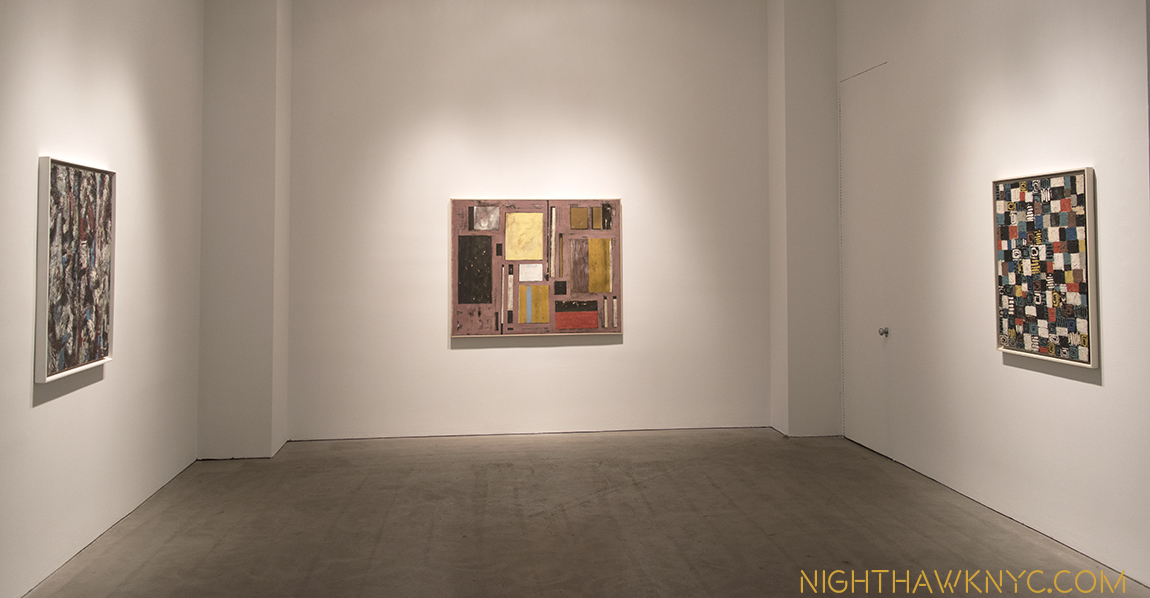
The room where Patti Smith’s Table & Chair stood 1 week before. “Equilibrium,” 1950, center, with “Lava,” 1949, left and “Untitled,” 1949, which seems to anticipate Jasper Johns, right Ms. Smith’s pencil inscriptions were to the right of the left rear corner pillar.
Yet, Ms. Smith was not entirely absent from this show. Even before the MoMA Retrospective, Lee Krasner’s influence had been felt by other artists, especially women artists- including Patti Smith, who wrote of her influence in the introduction to the show’s catalog-
“In 1967 I came to New York City, at twenty years old, with the knowledge of her reputation in tow. I sensed her strength of purpose and aspired to be like her one day. I also hoped, as she, to meet a fellow artist and work with him side by side. It would take, as attested by her choices, much personal strength to commit to the dual sacrifices required by art and love, yet it was my greatest wish.”
Completing the circle, a portrait of Lee Krasner by none other than Robert Mapplethorpe was also included in the catalog.
The show, simply titled, “Lee Krasner,” consists of 33 paintings, drawings and collages the Artist created over the FIFTY Years between 1931 and 1981. What struck me most was the dazzling array of styles it contained, beginning with a realistic Self Portrait, painted at about age 25 (1931-33). She seemed to be trying on painting styles the way other women try on fashion styles. Another interesting thing was that while some works were bursting with color, others were monochrome. “Color, for me, is a very mysterious thing,” she told Barbaralee Diamonstein in 1978.
But what about that “shadow?” When asked about Pollock’s influence on her, here’s what she said (in two different interviews) in my transcriptions-
In one, she told Dorothy Seckler– ” Certainly a great deal happened to me when I saw the Pollocks. Now Pollock saw my work too – I couldn’t measure what effect it had on him. We didn’t talk art – we didn’t have that kind of a relationship at all. In fact, we talked art talk only in a shop sense, but never in terms of discussions about art, so to speak. For one thing, Pollock really felt about it. When he did talk it was extremely pointed and meaningful and I understood what he meant. Naturally he was seeing my work as I certainly saw his.”4
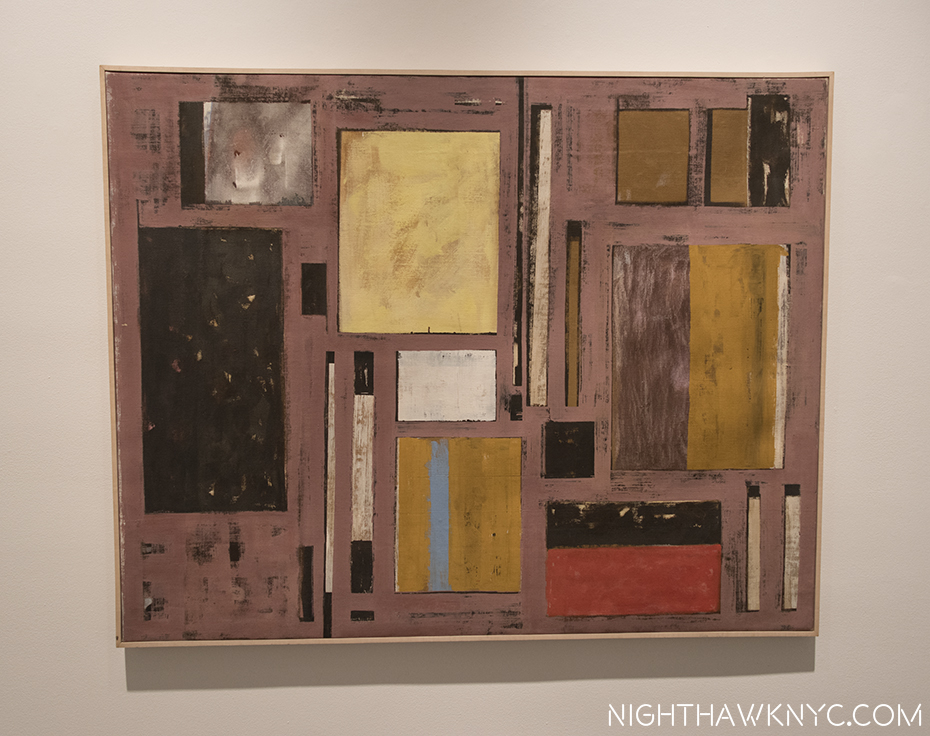
“Equilibrium,” 1950. Right in the middle of her marriage to Pollock. Pretty hard to see his style of the time in this.
While some of the works had elements of Pollock’s techniques, many others did not. Interestingly for me, except for “Lava” dated 1949 when they were married and living together in the Springs, Long Island, the works that had a bit of Pollock in them were from the 1960’s, well after Pollock’s passing. In fact, and most surprising, while I don’t see any works here that scream “Pollock,” there were works that were blatantly in the style of other Artists, including Mondrian, who she knew, and, perhaps most of all, Matisse, who she revered.
In the second interview, Barbaralee Diamondstein asked her directly in 1978- “What did you learn from Pollock’s work?”
“I don’t know. I just re…Let me put it this way. Other than what I’ve said before that the transition was as great…Let’s see. If we think of the Renaissance’s concept of space. …Where you are the artist up here, and whatever it is you are using perspective as your means. And you are making you, whatever you are doing with it…And if we go from that concept into cubism the thing is still there in the same sense. Nature is there. I am here as the artist. I observe the only thing is frontal now and that much has taken place. Now, in Pollock, once more there’s another transition. I can’t define it for you, sorry. It’s not my job.”
From what I’ve read, they worked separately. Krasner in a bedroom turned studio and Pollock out in back of the house in the amazing barn with the huge window on one side. I dont’ get the sense there was any collaboration. They would look at each other’s work, when asked to, but there was no direct “teaching” or anything like that. When asked (by Diamondsteen in the same interview)- “There are many who thought that all the while you were nurturing his career- you were not working. What were you doing during that period?” She said, again in my transcription- “I was working all the time. I doubt our relationship would have existed at all if I wasn’t working. In therms of what other people think, I can’t do anything about that. As long as I was able to work, I went about my business.”
For me, at least, all of this puts this “shadow” myth to rest, once and for all. Here is an Artist that was left out of the first rank of Abstract Expressionists, many of who appeared in that infamous Life Magazine picture titled “The Irascibles,” which should have included her. She was there in the beginning, knew many of them (even introducing Pollock to de Kooning), and her work was known and respected by them, and, shown with theirs.
So, why did she change her style so often? What was she seeking?
She told Dorothy Seckler- “Well, I do find that I swing from the lyric, to the dramatic and it doesn’t – you know, I have no way of knowing which phase is going to take over.”
And-
“I think my painting is so autobiographical if anyone can take the trouble to read it.” 5.
Hmmm…Based on the evidence at Miller, it’s very hard to read her work. Take “Rose Red,” dated 1958, 2 years after the death of her husband. It certainly doesn’t look it. It looks more like Matisse’s late cut-outs, full of life, joy, happiness and spring colors, interspersed with the titular red. Earlier and later works seems to be dialogues with other Artists- Mondrian, Matisse, as I said, maybe Paul Klee. (Untitled, 1949), but yes, there are elements of style that remind of Jackson Pollock, too. Yet, there are works that look ahead, as well. “Untitled,” 1949, as well as her “Hieroglyphic” works and “Little Paintings” of the same period now look like precursors of Jasper Johns. Her later collages, where she uses cut up, or torn pieces of figure study drawings (“Murdered,” she told Diamondstein) she had done in the 1930’s, casting them in a startling, unprecedented way, in a sort of new take on cubism, that also speaks to the amazing capabilities of her eye, first in seeing which drawings to reject, and then seeing this other possibility in them. Amazing.
Finally, there was this quote- “The one constant in life is change 6”
Lee Krasner was a unique Artist, who was capable of as many styles as almost any other Artist. For me, the most amazing thing about the Miller show was that every single work, no matter it’s style, holds up as a composition, something I feel is the hardest thing to do in so-called “abstract” (a term she didn’t like) Art, or in any work of Art. Part of this may be because she destroyed the works that didn’t hold up, leaving only 499 works in her Catalog Raisonne, a very small number considering her 50 year career- 10 a year! What does this tell me? She has one HELL of a good eye, which, in the end, is what I admire most about her work, and her. Along with John Graham, and others, she was among the first to “see” Pollock, after all- something I rarely see acknowledged. Seeing this show, with it’s amazing range of styles, it’s clear that she dabbled with influences but all the while stayed on her own path, following her own star, and relentlessly digging deep inside herself. From watching and reading her interviews, it quickly becomes apparent that she had a “strong personality”7. No doubt, she also had a very strong character, which served her in good stead in the company of all the other great artists of strong personalities, like Pollock, she was surrounded with most of her life. I doubt she’d have survived and gotten to where she got in her life, and where she is now, without that inner strength.
As I mentioned, Lee Krasner’s legacy lives on, additionally to her Art, through the Pollock-Krasner Foundation (which, since 1985, has awarded over 4,100 grants totaling over 65 million dollars to artists in 77 countries) and the Pollock-Krasner House & Study Center (their former home and studio), which I visited in 1999. It was, truly, an experience I will never forget, and one every Art lover should have on their bucket list. I was surprised how being in their environment gave me a completely new understanding of the Art they created there, which, all of a sudden, didn’t seem nearly as “abstract.”
In addition to this, there is the incalculable debt the world owes her for her generosity. A visit to the MoMA website revealed 49 works by Pollock alone that she gifted to them (making her the “unsung star” of their recent Pollock show, as I mentioned in my Pollock Post), a visit to The Met’s site yields about the same number, but who knows what the real total number of works of art that bear the source, “Gift of Lee Krasner Pollock” really is? Overlooked is that we are also increasingly indebted to her for giving her own work.
Taken in total, the shadow SHE now casts looms larger every day. As for the work? As she, herself, said, “I think the process of re-interpretation will continue and that many things will now be re-evaluated. I’m sharply aware of my own re-evaluation.8” This, also, applies to Philip Guston.
On the 5th Floor of MoMA, her “Untitled,” 1949, hangs on a wall adjacent to “One: Number 31, 1950,” one of her husband’s most well known (and largest) masterpieces. On the wall on the other side of the door next to it hangs Mark Rothko’s “No. 3/No. 13,” 1949, another masterpiece. Facing them is Philip Guston’s “Painting,” from 1954, a shimmering masterpiece from his early “abstract” years.
At The Met right now, another Krasner hangs right next to another early 1950’s Guston. Both works directly face another huge Pollock masterpiece, “Autumn Rhythm (Number 30),” 1950.
For me? That is the ultimate test of any work of Art- Hang it next to some masterpieces and let’s see how it does.
To be hung within inches of masterpieces by Mark Rothko, Philip Guston and Jackson Pollock is about as hard as a test gets for American “abstract” Art of this period.
Lee Krasner has found her place.
At last.
*-Soundtrack for this Post is “Dream of Life,” by Patti Smith and Fred “Sonic” Smith.
NighthawkNYC.com has been entirely self-funded & ad-free for over 8 years, during which 300 full length pieces have been published! If you’ve found it worthwhile, PLEASE donate to allow me to continue below. Thank you, Kenn.
You can also support it by buying Art, Art & Photography books, and Music from my collection! Art & Books may be found here. Music here and here.
Written & photographed by Kenn Sava for nighthawknyc.com unless otherwise credited. To send comments, thoughts, feedback or propositions click here. Click the white box on the upper right for the archives or to search them. Subscribe to be notified of new Posts below. Your information will be used for no other purpose.
- Gail Levin, “Lee Krasner,” P.1 ↩
- Levin, P.269, etc ↩
- Levin “Lee Krasner” P.4 ↩
- Oral history interview with Lee Krasner, 1964 Nov. 2-1968 Apr. 11, Archives of American Art, Smithsonian Institution ↩
- Levin, “Lee Krasner” P.11 Levin continues- “A few years later, she said, “I suppose everything is autobiographical in that sense, all experience is, but that doesn’t mean it’s naturalistic reading necessarily. I am sure that all events affect one…but I don’t think it means using a camera and snapping events.” ↩
- Interview, 1977 ↩
- Longtime associate B.H. Friedman in his “Intimate Introduction” to Robert Hobbs’ “Lee Krasner” P.25 ↩
- Levin, “Lee Krasner,” P12 ↩

